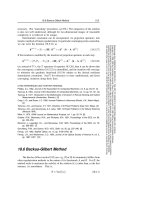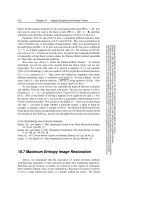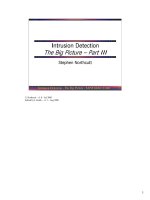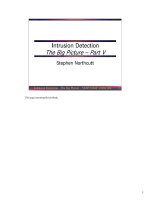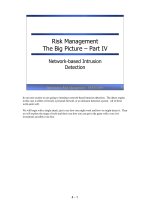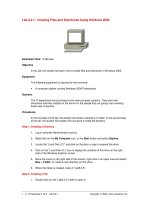Tài liệu Integral Equations and Inverse Theory part 6 docx
Bạn đang xem bản rút gọn của tài liệu. Xem và tải ngay bản đầy đủ của tài liệu tại đây (122.77 KB, 8 trang )
808
Chapter 18. Integral Equations and Inverse Theory
Sample page from NUMERICAL RECIPES IN C: THE ART OF SCIENTIFIC COMPUTING (ISBN 0-521-43108-5)
Copyright (C) 1988-1992 by Cambridge University Press.Programs Copyright (C) 1988-1992 by Numerical Recipes Software.
Permission is granted for internet users to make one paper copy for their own personal use. Further reproduction, or any copying of machine-
readable files (including this one) to any servercomputer, is strictly prohibited. To order Numerical Recipes books,diskettes, or CDROMs
visit website or call 1-800-872-7423 (North America only),or send email to (outside North America).
The single central idea in inverse theory is the prescription
minimize: A + λB (18.4.12)
for various values of 0 <λ<∞along the so-called trade-off curve (see Figure
18.4.1), and then to settle on a “best” value of λ by one or another criterion, ranging
from fairly objective (e.g., making χ
2
= N ) to entirely subjective. Successful
methods, several of which we will now describe, differ as to their choices of A and
B, as to whether the prescription (18.4.12) yields linear or nonlinear equations, as
to their recommended method for selecting a final λ, and as to their practicality for
computer-intensive two-dimensional problems like image processing.
They also differ as to the philosophical baggage that they (or rather, their
proponents) carry. We have thus far avoided the word “Bayesian.” (Courts have
consistently held that academic license does not extend to shouting “Bayesian” in a
crowded lecture hall.) But it is hard, nor have we any wish, to disguise the fact that
B has something to do with aprioriexpectation, or knowledge, of a solution, while
A has something to do with a posteriori knowledge. The constant λ adjudicates a
delicate compromise between the two. Some inverse methods have acquired a more
Bayesian stamp than others, but we think that this is purely an accident of history.
An outsider looking only at the equations that are actually solved, and not at the
accompanying philosophicaljustifications, would have adifficult time separating the
so-called Bayesian methods from the so-called empirical ones, we think.
The next three sections discuss three different approaches to the problem of
inversion, which have had considerable success in different fields. All three fit
within the general framework that we have outlined, but they are quite different in
detail and in implementation.
CITED REFERENCES AND FURTHER READING:
Craig, I.J.D., and Brown, J.C. 1986,
Inverse Problems in Astronomy
(Bristol, U.K.: Adam Hilger).
Twomey, S. 1977,
Introduction to the Mathematics of Inversion in Remote Sensing and Indirect
Measurements
(Amsterdam: Elsevier).
Tikhonov, A.N., and Arsenin, V.Y. 1977,
Solutions of Ill-Posed Problems
(New York: Wiley).
Tikhonov, A.N., and Goncharsky, A.V. (eds.) 1987,
Ill-Posed Problems in the Natural Sciences
(Moscow: MIR).
Parker, R.L. 1977,
Annual Review of Earth and Planetary Science
, vol. 5, pp. 35–64.
Frieden, B.R. 1975, in
Picture Processing and Digital Filtering
, T.S. Huang, ed. (New York:
Springer-Verlag).
Tarantola, A. 1987,
Inverse Problem Theory
(Amsterdam: Elsevier).
Baumeister, J. 1987,
Stable Solution of Inverse Problems
(Braunschweig, Germany: Friedr. Vieweg
& Sohn) [mathematically oriented].
Titterington, D.M. 1985,
Astronomy and Astrophysics
, vol. 144, pp. 381–387.
Jeffrey, W., and Rosner, R. 1986,
Astrophysical Journal
, vol. 310, pp. 463–472.
18.5 Linear Regularization Methods
What we will call linear regularization is also called the Phillips-Twomey
method
[1,2]
,theconstrained linear inversion method
[3]
,themethod of regulariza-
tion
[4]
,andTikhonov-Miller regularization
[5-7]
. (It probably has other names also,
18.5 Linear Regularization Methods
809
Sample page from NUMERICAL RECIPES IN C: THE ART OF SCIENTIFIC COMPUTING (ISBN 0-521-43108-5)
Copyright (C) 1988-1992 by Cambridge University Press.Programs Copyright (C) 1988-1992 by Numerical Recipes Software.
Permission is granted for internet users to make one paper copy for their own personal use. Further reproduction, or any copying of machine-
readable files (including this one) to any servercomputer, is strictly prohibited. To order Numerical Recipes books,diskettes, or CDROMs
visit website or call 1-800-872-7423 (North America only),or send email to (outside North America).
since it is so obviouslya good idea.) In itssimplest form, the method is an immediate
generalization of zeroth-order regularization (equation 18.4.11, above). As before,
the functional A is taken to be the χ
2
deviation, equation (18.4.9), but the functional
B is replaced by more sophisticated measures of smoothness that derive from first
or higher derivatives.
For example, suppose that your aprioribelief is that a credible u(x) is not too
different from a constant. Then a reasonable functional to minimize is
B∝
[u
(x)]
2
dx ∝
M−1
µ=1
[u
µ
− u
µ+1
]
2
(18.5.1)
since it is nonnegative and equal to zero only when u(x) is constant. Here
u
µ
≡ u(x
µ
), and the second equality (proportionality) assumes that the x
µ
’s are
uniformly spaced. We can write the second form of B as
B = |B ·
u|
2
=
u · (B
T
· B) ·
u ≡
u · H ·
u (18.5.2)
where
u is the vector of components u
µ
,µ=1, ,M, B is the (M − 1) × M
first difference matrix
B =
−1100000··· 0
0 −110000··· 0
.
.
.
.
.
.
.
.
.
0 ··· 0000−110
0··· 00000−11
(18.5.3)
and H is the M × M matrix
H = B
T
· B =
1 −100000··· 0
−12−10000··· 0
0 −12−1000··· 0
.
.
.
.
.
.
.
.
.
0 ··· 000−12−10
0··· 0000−12−1
0··· 00000−11
(18.5.4)
Note that B has one fewer row than column. It follows that the symmetric H
is degenerate; it has exactly one zero eigenvalue corresponding to the value of a
constant function, any one of which makes B exactly zero.
If, just as in §15.4, we write
A
iµ
≡ R
iµ
/σ
i
b
i
≡ c
i
/σ
i
(18.5.5)
then, using equation (18.4.9), the minimization principle (18.4.12) is
minimize: A + λB = |A ·
u − b|
2
+ λ
u · H ·
u (18.5.6)
This can readily be reduced to a linear set of normal equations,justasin§15.4: The
components u
µ
of the solution satisfy the set of M equations in M unknowns,
ρ
i
A
iµ
A
iρ
+ λH
µρ
u
ρ
=
i
A
iµ
b
i
µ =1,2, ,M (18.5.7)
810
Chapter 18. Integral Equations and Inverse Theory
Sample page from NUMERICAL RECIPES IN C: THE ART OF SCIENTIFIC COMPUTING (ISBN 0-521-43108-5)
Copyright (C) 1988-1992 by Cambridge University Press.Programs Copyright (C) 1988-1992 by Numerical Recipes Software.
Permission is granted for internet users to make one paper copy for their own personal use. Further reproduction, or any copying of machine-
readable files (including this one) to any servercomputer, is strictly prohibited. To order Numerical Recipes books,diskettes, or CDROMs
visit website or call 1-800-872-7423 (North America only),or send email to (outside North America).
or, in vector notation,
(A
T
· A + λH) ·
u = A
T
· b (18.5.8)
Equations (18.5.7) or (18.5.8) can be solved by the standard techniques of
Chapter 2, e.g., LU decomposition. The usual warnings about normal equations
being ill-conditioned do not apply, since the whole purpose of the λ term is to cure
that same ill-conditioning. Note, however, that the λ term by itself is ill-conditioned,
since it does not select a preferred constant value. You hope your data can at
least do that!
Although inversionof the matrix (A
T
· A+ λH) is not generally the best way to
solve for
u, let us digress to write the solution to equation (18.5.8) schematically as
u =
1
A
T
· A + λH
· A
T
· A
A
−1
· b (schematic only!) (18.5.9)
where the identity matrix in the form A · A
−1
has been inserted. This is schematic
not only because the matrix inverse is fancifully written as a denominator, but
also because, in general, the inverse matrix A
−1
does not exist. However, it is
illuminating to compare equation (18.5.9) with equation (13.3.6) for optimal or
Wiener filtering, or with equation (13.6.6) for general linear prediction. One sees
that A
T
· A plays the role of S
2
, the signal power or autocorrelation, while λH
plays the role of N
2
, the noise power or autocorrelation. The term in parentheses
in equation (18.5.9) is something like an optimal filter, whose effect is to pass the
ill-posed inverse A
−1
· b through unmodified when A
T
· A is sufficiently large, but
to suppress it when A
T
· A is small.
The above choices of B and H are only the simplest in an obvious sequence of
derivatives. If your aprioribelief is that a linear function is a good approximation
to u(x), then minimize
B∝
[u
(x)]
2
dx ∝
M−2
µ=1
[−u
µ
+2u
µ+1
− u
µ+2
]
2
(18.5.10)
implying
B =
−12−10000··· 0
0 −12−1000··· 0
.
.
.
.
.
.
.
.
.
0 ··· 000−12−10
0··· 0000−12−1
(18.5.11)
and
H = B
T
· B =
1 −210000··· 0
−25−41000··· 0
1 −46−4100··· 0
01−46−410··· 0
.
.
.
.
.
.
.
.
.
0 ··· 01−46−410
0··· 001−46−41
0··· 0001−45−2
0··· 00001−21
(18.5.12)
18.5 Linear Regularization Methods
811
Sample page from NUMERICAL RECIPES IN C: THE ART OF SCIENTIFIC COMPUTING (ISBN 0-521-43108-5)
Copyright (C) 1988-1992 by Cambridge University Press.Programs Copyright (C) 1988-1992 by Numerical Recipes Software.
Permission is granted for internet users to make one paper copy for their own personal use. Further reproduction, or any copying of machine-
readable files (including this one) to any servercomputer, is strictly prohibited. To order Numerical Recipes books,diskettes, or CDROMs
visit website or call 1-800-872-7423 (North America only),or send email to (outside North America).
This H has two zero eigenvalues, corresponding to the two undetermined parameters
of a linear function.
If your aprioribelief is that a quadratic function is preferable, then minimize
B∝
[u
(x)]
2
dx ∝
M−3
µ=1
[−u
µ
+3u
µ+1
− 3u
µ+2
+ u
µ+3
]
2
(18.5.13)
with
B =
−13−31000··· 0
0 −13−3100··· 0
.
.
.
.
.
.
.
.
.
0 ··· 00−13−310
0··· 000−13−31
(18.5.14)
and now
H =
1 −33−100000··· 0
−310−12 6 −10000··· 0
3 −12 19 −15 6 −1000··· 0
−16−15 20 −15 6 −100··· 0
0 −16−15 20 −15 6 −10··· 0
.
.
.
.
.
.
.
.
.
0 ··· 0 −16−15 20 −15 6 −10
0··· 00−16−15 20 −15 6 −1
0 ··· 000−16−15 19 −12 3
0 ··· 0000−16−12 10 −3
0 ··· 00000−13−31
(18.5.15)
(We’ll leave the calculation of cubics and above to the compulsive reader.)
Notice that you can regularize with “closeness to a differential equation,” if
you want. Just pick B to be the appropriate sum of finite-difference operators (the
coefficients can depend on x), and calculate H = B
T
· B. You don’t need to know
the values of your boundary conditions, since B can have fewer rows than columns,
as above; hopefully, your data will determine them. Of course, if you do know some
boundary conditions, you can build these into B too.
With all the proportionalitysigns above, you may have lost track of what actual
value of λ to try first. A simple trick for at least getting “on the map” is to first try
λ = Tr(A
T
· A)/Tr(H)(18.5.16)
where Tr is the trace of the matrix (sum of diagonal components). This choice
will tend to make the two parts of the minimization have comparable weights, and
you can adjust from there.
As for what is the “correct” value of λ, an objective criterion, if you know
your errors σ
i
with reasonable accuracy, is to make χ
2
(that is, |A ·
u − b|
2
) equal
to N, the number of measurements. We remarked above on the twin acceptable
choices N ± (2N)
1/2
. A subjective criterion is to pick any value that you like in the
812
Chapter 18. Integral Equations and Inverse Theory
Sample page from NUMERICAL RECIPES IN C: THE ART OF SCIENTIFIC COMPUTING (ISBN 0-521-43108-5)
Copyright (C) 1988-1992 by Cambridge University Press.Programs Copyright (C) 1988-1992 by Numerical Recipes Software.
Permission is granted for internet users to make one paper copy for their own personal use. Further reproduction, or any copying of machine-
readable files (including this one) to any servercomputer, is strictly prohibited. To order Numerical Recipes books,diskettes, or CDROMs
visit website or call 1-800-872-7423 (North America only),or send email to (outside North America).
range 0 <λ<∞, depending on your relative degree of belief in the aprioriand a
posteriori evidence. (Yes, people actually do that. Don’t blame us.)
Two-Dimensional Problems and Iterative Methods
Up to now our notation has been indicative of a one-dimensional problem,
finding u(x) or u
µ
= u(x
µ
). However, all of the discussion easily generalizes to the
problem of estimating a two-dimensional set of unknowns u
µκ
, µ =1, ,M, κ=
1, ,K, corresponding, say, to the pixel intensities of a measured image. In this
case, equation (18.5.8) is still the one we want to solve.
In image processing, it is usual to have the same number of input pixels in a
measured “raw” or “dirty” image as desired “clean” pixels in the processed output
image, so the matrices R and A (equation 18.5.5) are square and of size MK×MK.
A is typically much too large to represent as a full matrix, but often it is either (i)
sparse, with coefficients blurring an underlying pixel (i, j) only into measurements
(i±few,j±few),or (ii)translationallyinvariant,sothatA
(i,j)(µ,ν)
= A(i−µ, j−ν).
Both of these situations lead to tractable problems.
In the case of translational invariance, fast Fourier transforms (FFTs) are the
obvious method of choice. The general linear relation between underlying function
and measured values (18.4.7) now becomes a discrete convolution like equation
(13.1.1). If k denotes a two-dimensional wave-vector, then the two-dimensional
FFT takes us back and forth between the transform pairs
A(i − µ, j − ν) ⇐⇒
A( k ) b
( i,j)
⇐⇒
b ( k ) u
( i,j)
⇐⇒ u ( k )(18.5.17)
We also need a regularization or smoothing operator B and the derived H = B
T
· B.
One popular choice for B is the five-point finite-difference approximation of the
Laplacian operator, that is, the difference between the value of each point and the
average of its four Cartesian neighbors. In Fourier space, this choice implies,
B(k) ∝ sin
2
(πk
1
/M )sin
2
(πk
2
/K)
H(k) ∝ sin
4
(πk
1
/M )sin
4
(πk
2
/K)
(18.5.18)
In Fourier space, equation (18.5.7) is merely algebraic, with solution
u(k)=
A*(k)
b(k)
|
A(k)|
2
+ λ
H(k)
(18.5.19)
where asterisk denotes complex conjugation. You can make use of the FFT routines
for real data in §12.5.
Turn now to the case where A is not translationally invariant. Direct solution
of (18.5.8) is now hopeless, since the matrix A is just too large. We need some
kind of iterative scheme.
One way to proceed is to use the full machinery of the conjugate gradient
method in §10.6 to find the minimum of A + λB, equation (18.5.6). Of the various
methods in Chapter 10, conjugate gradient is the unique best choice because (i)
it does not require storage of a Hessian matrix, which would be infeasible here,
18.5 Linear Regularization Methods
813
Sample page from NUMERICAL RECIPES IN C: THE ART OF SCIENTIFIC COMPUTING (ISBN 0-521-43108-5)
Copyright (C) 1988-1992 by Cambridge University Press.Programs Copyright (C) 1988-1992 by Numerical Recipes Software.
Permission is granted for internet users to make one paper copy for their own personal use. Further reproduction, or any copying of machine-
readable files (including this one) to any servercomputer, is strictly prohibited. To order Numerical Recipes books,diskettes, or CDROMs
visit website or call 1-800-872-7423 (North America only),or send email to (outside North America).
and (ii) it does exploit gradient information, which we can readily compute: The
gradient of equation (18.5.6) is
∇(A + λB)=2[(A
T
·A+λH)·
u−A
T
·b](18.5.20)
(cf. 18.5.8). Evaluation of both the function and the gradient should of course take
advantage of the sparsity of A, for example via the routines sprsax and sprstx
in §2.7. We will discuss the conjugate gradient technique further in §18.7, in the
context of the (nonlinear) maximum entropy method. Some of that discussion can
apply here as well.
The conjugate gradient method notwithstanding, application of the unsophis-
ticated steepest descent method (see §10.6) can sometimes produce useful results,
particularly when combined with projections onto convex sets (see below). If the
solution after k iterations is denoted
u
(k)
,thenafterk+1iterations we have
u
(k+1)
=[1−(A
T
·A+λH)] ·
u
(k)
+ A
T
· b (18.5.21)
Here isa parameter that dictates how far to move in the downhillgradient direction.
The method converges when is small enough, in particular satisfying
0 <<
2
max eigenvalue(A
T
· A + λH)
(18.5.22)
There exist complicated schemes for finding optimal values or sequences for ,
see
[7]
; or, one can adopt an experimental approach, evaluating (18.5.6) to be sure
that downhill steps are in fact being taken.
In those image processing problems where the final measure of success is
somewhat subjective (e.g., “how good does the picture look?”), iteration (18.5.21)
sometimes produces significantly improved images long before convergence is
achieved. This probably accounts for much of its use, since its mathematical
convergence is extremely slow. In fact, (18.5.21) can be used with H =0,in
which case the solution is not regularized at all, and full convergence would be
disastrous! This is called Van Cittert’s method and goes back to the1930s. A number
of iterations the order of 1000 is not uncommon
[7]
.
Deterministic Constraints: Projections onto Convex Sets
A set of possible underlying functions (or images) {
u} is said to be convex if,
for any two elements
u
a
and
u
b
in the set, all the linearly interpolated combinations
(1 − η)
u
a
+ η
u
b
0 ≤ η ≤ 1(18.5.23)
are also in the set. Many deterministic constraints that one might want to impose on
the solution
u to an inverse problem in fact define convex sets, for example:
• positivity
• compact support (i.e., zero value outside of a certain region)
814
Chapter 18. Integral Equations and Inverse Theory
Sample page from NUMERICAL RECIPES IN C: THE ART OF SCIENTIFIC COMPUTING (ISBN 0-521-43108-5)
Copyright (C) 1988-1992 by Cambridge University Press.Programs Copyright (C) 1988-1992 by Numerical Recipes Software.
Permission is granted for internet users to make one paper copy for their own personal use. Further reproduction, or any copying of machine-
readable files (including this one) to any servercomputer, is strictly prohibited. To order Numerical Recipes books,diskettes, or CDROMs
visit website or call 1-800-872-7423 (North America only),or send email to (outside North America).
• known bounds (i.e., u
L
(x) ≤ u(x) ≤ u
U
(x) for specified functions u
L
and u
U
).
(In this last case, the bounds might be related to an initial estimate and its error bars,
e.g., u
0
(x) ± γσ(x),whereγis of order 1 or 2.) Notice that these, and similar,
constraints can be either in the image space, or in the Fourier transform space, or
(in fact) in the space of any linear transformation of
u.
If C
i
is a convex set, then P
i
is called a nonexpansive projection operator onto
that set if (i) P
i
leaves unchanged any
u already in C
i
, and (ii) P
i
maps any
u outside
C
i
to the closest element of C
i
, in the sense that
|P
i
u −
u|≤|
u
a
−
u| for all
u
a
in C
i
(18.5.24)
Whilethis definitionsoundscomplicated, examples are very simple: A nonexpansive
projection onto the set of positive
u’s is “set all negative components of
u equal
to zero.” A nonexpansive projection onto the set of u(x)’s bounded by u
L
(x) ≤
u(x) ≤ u
U
(x) is “set all values less than the lower bound equal to that bound, and
set all values greater than the upper bound equal to that bound.” A nonexpansive
projection onto functions with compact support is “zero the values outside of the
region of support.”
The usefulness of these definitions is the followingremarkable theorem: Let C
be the intersection of m convex sets C
1
,C
2
, ,C
m
. Then the iteration
u
(k+1)
=(P
1
P
2
···P
m
)
u
(k)
(18.5.25)
will converge to C from all starting points, as k →∞. Also, if C is empty (there
is no intersection), then the iteration will have no limit point. Application of this
theorem is called the method of projections onto convex sets or sometimes POCS
[7]
.
A generalization of the POCS theorem is that the P
i
’s can be replaced by
asetofT
i
’s,
T
i
≡ 1 + β
i
(P
i
− 1)0<β
i
<2(18.5.26)
A well-chosen set of β
i
’s can accelerate the convergence to the intersection set C.
Some inverse problems can be completely solved by iteration (18.5.25) alone!
For example, a problem that occurs in both astronomical imaging and X-ray
diffraction work is to recover an image given only the modulus of its Fourier
transform (equivalent to its power spectrum or autocorrelation) and not the phase.
Here three convex sets can be utilized: the set of all images whose Fourier transform
has the specified modulus to within specified error bounds; the set of all positive
images; and the set of all images with zero intensity outside of some specified region.
In this case the POCS iteration (18.5.25) cycles among these three, imposing each
constraint in turn; FFTs are used to get in and out of Fourier space each time the
Fourier constraint is imposed.
The specific application of POCS to constraints alternately in the spatial and
Fourier domains is also known as the Gerchberg-Saxton algorithm
[8]
. While this
algorithm is non-expansive, and is frequently convergent in practice, it has not been
proved to converge in all cases
[9]
. In the phase-retrieval problem mentioned above,
the algorithm often “gets stuck” on a plateau for many iterations before making
sudden, dramatic improvements. As many as 10
4
to 10
5
iterations are sometimes
18.6 Backus-Gilbert Method
815
Sample page from NUMERICAL RECIPES IN C: THE ART OF SCIENTIFIC COMPUTING (ISBN 0-521-43108-5)
Copyright (C) 1988-1992 by Cambridge University Press.Programs Copyright (C) 1988-1992 by Numerical Recipes Software.
Permission is granted for internet users to make one paper copy for their own personal use. Further reproduction, or any copying of machine-
readable files (including this one) to any servercomputer, is strictly prohibited. To order Numerical Recipes books,diskettes, or CDROMs
visit website or call 1-800-872-7423 (North America only),or send email to (outside North America).
necessary. (For “unsticking” procedures, see
[10]
.) The uniqueness of the solution
is also not well understood, although for two-dimensional images of reasonable
complexity it is believed to be unique.
Deterministic constraints can be incorporated, via projection operators, into
iterative methods of linear regularization. In particular,rearranging terms somewhat,
we can write the iteration (18.5.21) as
u
(k+1)
=[1−λH] ·
u
(k)
+ A
T
· (b − A ·
u
(k)
)(18.5.27)
If the iteration is modified by the insertion of projection operators at each step
u
(k+1)
=(P
1
P
2
···P
m
)[1 − λH] ·
u
(k)
+ A
T
· (b − A ·
u
(k)
)(18.5.28)
(or, instead of P
i
’s, the T
i
operators of equation 18.5.26), then it can be shown that
the convergence condition (18.5.22) is unmodified, and the iteration will converge
to minimize the quadratic functional (18.5.6) subject to the desired nonlinear
deterministic constraints. See
[7]
for references to more sophisticated, and faster
converging, iterations along these lines.
CITED REFERENCES AND FURTHER READING:
Phillips, D.L. 1962,
Journal of the Association for Computing Machinery
, vol. 9, pp. 84–97. [1]
Twomey, S. 1963,
Journal of the Association for Computing Machinery
, vol. 10, pp. 97–101. [2]
Twomey, S. 1977,
Introduction to the Mathematics of Inversion in Remote Sensing and Indirect
Measurements
(Amsterdam: Elsevier). [3]
Craig, I.J.D., and Brown, J.C. 1986,
Inverse Problems in Astronomy
(Bristol, U.K.: Adam Hilger).
[4]
Tikhonov, A.N., and Arsenin, V.Y. 1977,
Solutions of Ill-Posed Problems
(New York: Wiley). [5]
Tikhonov, A.N., and Goncharsky, A.V. (eds.) 1987,
Ill-Posed Problems in the Natural Sciences
(Moscow: MIR).
Miller, K. 1970,
SIAM Journal on Mathematical Analysis
, vol. 1, pp. 52–74. [6]
Schafer, R.W., Mersereau, R.M., and Richards, M.A. 1981,
Proceedings of the IEEE
, vol. 69,
pp. 432–450.
Biemond, J., Lagendijk, R.L., and Mersereau, R.M. 1990,
Proceedings of the IEEE
, vol. 78,
pp. 856–883. [7]
Gerchberg, R.W., and Saxton, W.O. 1972,
Optik
, vol. 35, pp. 237–246. [8]
Fienup, J.R. 1982,
Applied Optics
, vol. 15, pp. 2758–2769. [9]
Fienup, J.R., and Wackerman, C.C. 1986,
Journal of the Optical Society of America A
,vol.3,
pp. 1897–1907. [10]
18.6 Backus-Gilbert Method
The Backus-Gilbert method
[1,2]
(see, e.g.,
[3]
or
[4]
for summaries) differs from
other regularization methods in the nature of its functionals A and B.ForB,the
method seeks to maximize the stability of the solution u(x) rather than, in the first
instance, its smoothness. That is,
B≡Var [ u(x )] (18.6.1)
